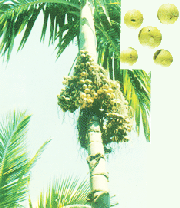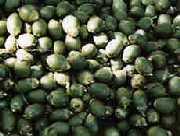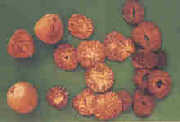Betel nuts, one of the four famous Chinese medicines, are mainly produced in South China's Hainan province, where the tradition of planting betel nuts has existed for over 1,500 years. The betel nuts became well known as early as in the Tang (618-907) and Song (9 60-1279) dynasties, when the provincial officials used betel nuts as tributes to the royal court. Over the years, a unique "betel-nut culture" has been fostered.
60-1279) dynasties, when the provincial officials used betel nuts as tributes to the royal court. Over the years, a unique "betel-nut culture" has been fostered.
According to locals and historical records, the custom of entertaining guests with betel nuts has long existed in Hainan Province. As is recorded in "Southern plants- betel nut", an encyclopedia compiled by Dao Gu of the Jin Dynasty (265-420), "Hainan people, upon the arrival of distinguished guests, will invariably present the nuts". Another book also records, "Not tea but betel nuts are served when guests arrive". These and other records show that Hainan people have long regarded betel nuts as superior gifts, believing that "Nothing but betel nuts can be given as gifts to relatives and friends".
 More than 800 years ago, Su Dongpo, a famous poet of the Song Dynasty, depicted the scene of a Li girl wearing jasmine flowers on her head and chewing betel nuts; this shows that loving, growing, and chewing betel nuts have long been the tradition for Hainan people.
More than 800 years ago, Su Dongpo, a famous poet of the Song Dynasty, depicted the scene of a Li girl wearing jasmine flowers on her head and chewing betel nuts; this shows that loving, growing, and chewing betel nuts have long been the tradition for Hainan people.
Today, in Wangning, Lingshui, and Wuzhishan, where betel nuts are abundant, people still view the nuts as a symbol of blessings and friendship. When guests arrive, the host will first offer them with betel nuts, and even those incapable of chewing betel nuts will accept as a show of respect. On festivals, such as theSpring Festival, betel nuts are a must-item for every household.
For the young people, betel nuts are tokens of love. When a lad takes a fancy to a girl, he has to first present betel nuts to the girl's family, commonly known as "Fang Binlang (giving betel nuts)", and the family's acceptance of the betel nuts means their approval of the proposal. At the wedding ceremony, betel nuts are even more important, as the newlyweds will distribute them to attending guests.
 The way Hainan people eat betel nuts is quite complex. First, betel nuts are sliced, and then a condiment, which is made from oyster shell flour and betel pepper, is smeared over the inside and outside surface of the sliced nuts.
The way Hainan people eat betel nuts is quite complex. First, betel nuts are sliced, and then a condiment, which is made from oyster shell flour and betel pepper, is smeared over the inside and outside surface of the sliced nuts.
Chewing the betel nuts, while bitter at first, gives a pleasant and tipsy feeling in the end, just as what Su Dongpo said in one of his poems that one could get drunk by chewing betel nuts.
So next time, when you are in Hainan, do not forget to have a taste of the betel-nut culture while enjoying the natural scenery of the treasure island.
Author: Jessie
